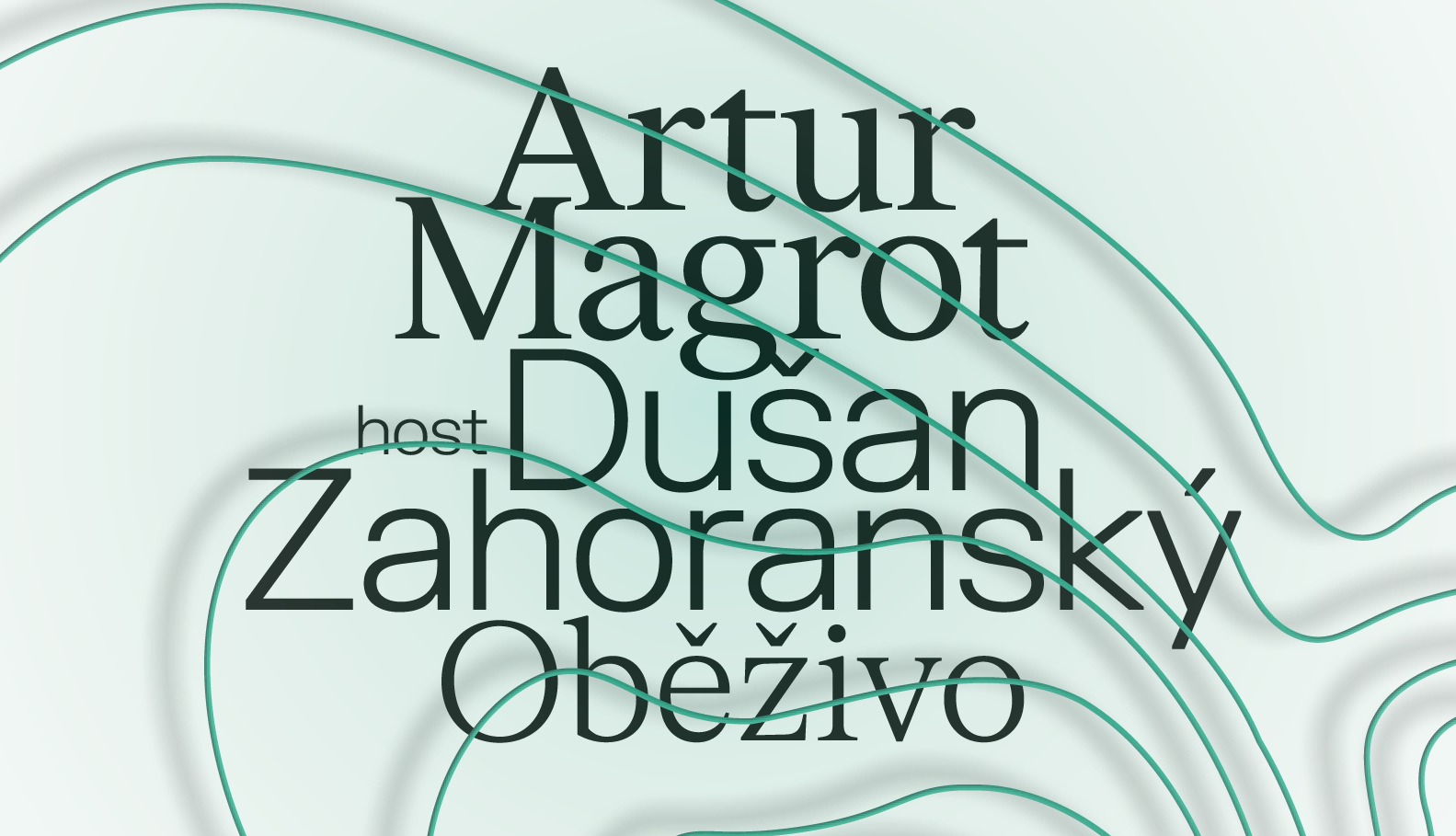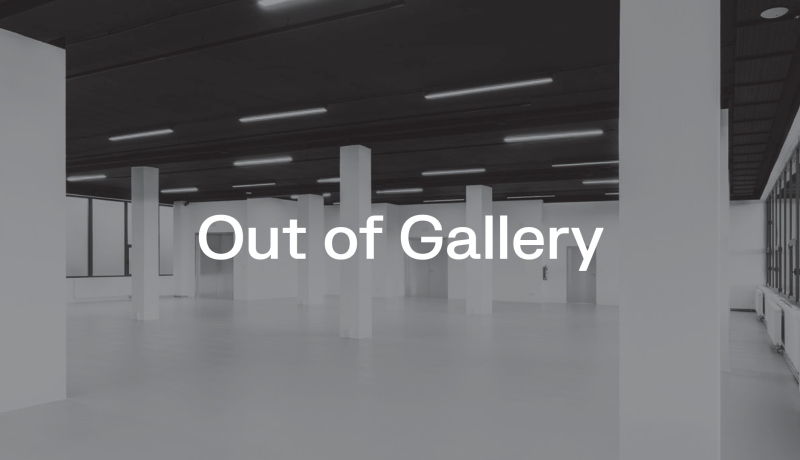Artur Magrot: OBĚŽIVO
Gallery 2 / 24. 4. – 27. 7. 2024
Artur MAGROT: OBĚŽIVO
Hosted by Dušan Zahoranský
Curator: Nina Moravcová
“Art has a complex relationship with power. On the one hand, it serves as both a conduit for propaganda and a preserver of the status quo; on the other hand, it harbours a rich tapestry of subversive expressions, which aim to dissect and challenge prevailing ideologies and social norms. Artists navigate this terrain, employing a myriad of techniques—whether overtly or covertly, through symbolism or clandestine operations—to confront entrenched power dynamics. Whether we classify these activities as unofficial, engaged, cryptic, or activist, they creatively harness power as a source of themes, attitudes, and strategies for their work.” (Magrot, 2023)
With these words, visual artist Artur Magrot introduces his elaborate dissertation, in which he maps this type of artistic expression in an attempt to delve deeper into the self-reproductive processes of power that he has long been exploring in his work. This interest in subversive artistic strategies, present in Magrot’s work perhaps from the very beginning, represents an intersection where he encounters the thinking of his mentor and long-time friend, Dušan Zahoranský. While Magrot, in his video installations and artistic projects over the past five years, delves deeply beneath the surface of lived, often marginal, experiences to inquire about the possibilities of our functioning within a system that is not always entirely friendly, Zahoranský essentially does the same, but in a completely different manner. In line with his previous work—dedicated to exploring the communication possibilities of writing and symbols—he contributes to the dialogue through seemingly banal to absurd comments. By means of messages encoded in maximum brevity, in line with Harari’s assertion that “in a world deluged by irrelevant information, clarity is power” (Yuval Noah Harari, 21 Lessons for the 21st Century, 2021, p. 11), he not only provides a concentrated statement but also uses it as a detonator for the viewer’s thinking. The subversiveness of his gesture lies in his ability to juxtapose his objects and installations, often consisting of stripped-down words or disconnected phrases, into unexpected situations (often in public spaces). This points to their potential interpretation on several levels.
The artists’ joint installation, prepared for Gallery 2, consists of six “tables”, or work desks rather. It builds upon Magrot’s latest artistic project “OBĚ-ŽIVO,” realised as part of the artists’ doctoral research and presented in the form of an exhibition at the XY Gallery in Olomouc (11/2023). In it, Magrot pointed to a lesser-known story unfolding against the backdrop of the creation of the Czechoslovak crown. Behind the realisation of the longest-used coin in our modern history (1957–1992) lay a curious set of circumstances that led to the selection of the work by Marie Uchytilová, a graduate of the Academy of Fine Arts in Prague, out of dozens of proposed medal designs. She “encoded” the portrait of Bedřiška Synková, a young girl sentenced to ten years in prison in 1955 for illegally leading a scout troop after being found guilty in a kangaroo court. This coin, with the assistance of state power, became perhaps the greatest memorial to its own victims, constantly in the sight of the ruling elite.
Magrot built on this story and updated its narrative through a modified crown coin, which delivers a message about the sacrifices of the current social order. He replaced the Czechoslovak coat of arms on the reverse side with a symbol of the contemporary precarious class – a reflective safety vest. He surrounded it with the words EXECUTION – DEPRIVATION – LIPOSUCTION – FEAR, which, according to his own experience, best define the vicious circle in which members of today’s precariat find themselves. Above all, the third word LIPOSUCTION, in a general sense, serves as a metaphor for the depletion of human resources to sustain nonstop economic operations, a concept swiftly embraced by society despite its origins in relentless consumer convenience, often at the expense of labourers.
Magrot then had the obverse side of the coin modified to include inserted words/prompts with the help of artificial intelligence. He chose words like “punished body,” “power,” and “surveillance,” derived from Michel Foucault’s book Discipline and Punish. Magrot had a new coin minted that matched the parameters of the current ten-crown coin in circulation. In the exhibition in question, he presented the coin to the audience via a vending machine for them to take as a miniature artefact or souvenir or for them to introduce into figurative circulation. The source data processed for minting the coin was then used to create a monumental relief. Its appearance alludes to the complexity of the issue tackled in this work, as well as the elusive nature of its contours, which may prove challenging to grasp for those not directly involved.
In the exhibition in Ústí, Magrot further blurs the contours of this relief by suspending it from the wall. He places it on a tabletop, where it transforms into a three-dimensional blank map, a model of a landscape that can become the subject of metaphorical interpretation. Its dynamically modelled surface is the result of the action of an untamed element – the flow of money, which carries everything in its path and leaves behind deep channels and washed-away sediments. At times, like still water, it erodes the banks, and its effects only become apparent over time. Often it is artificially regulated, flowing unnoticed beneath the surface like an underground river, occasionally surfacing or disappearing irretrievably. It is precisely this loss that is accentuated by another in the series of “tables” – Zahoranský’s object entitled “10 Czech crowns”, which is a virtual three-dimensional graph depicting the share of public funds that dissolved into bribes in the past year. A similar object was already presented by the artist to the Ústí public back in 2013 as part of the group exhibition “Minimal Durability” on display at the Emil Filla Gallery, which reflected a wide range of artistic statements within the context of the year prior (2012). His gesture was coupled with a recent uproar over the embezzlement of public funds, as he cut out a section representing 16% from each of the hundred crown coins stacked into the fireplace, which “symbolically [embodied] the percentage of missing public funds that [had been] unprecedentedly embezzled in our country.” (Zahoranský, 2013) Despite a 12-year time gap during which embezzlement decreased only slightly by 6%, he chose to revisit the theme again with the same determination, expressing his lack of trust in the existing system.
The other two tables serve as a research backdrop, whether real—hinting at the process behind Magrot’s project dedicated to the Czech crown coin—or fictional, with objects resembling book volumes or dust jackets. Through these, Zahoranský constructs frameworks for future understanding of phenomena we currently only speculate about. These “manuals” may one day offer insights into navigating “In a flood of foreign and personal decisions,” tackling “Processing huge disparate data,” or strategising “How to earn as little as possible,” helping us adapt to the evolving demands of the job market. Zahoranský further explores these themes with straightforward slogans on other tables in the series, such as “I apologise for the bribe on your behalf,” “I will create an impression that your opinion matters to someone,” or “I will find a substitute target for channelling your frustrations.” It is as if through these, he contemplates future employment prospects and consumer needs. With humour and exaggeration, he devises self-promotional slogans that might aid his success in securing a position, as the only certainty may be the persistent demand for “dirty work” or improving one’s reputation.
The appearance of the final table, in contrast, reflects considerations about a recently vacated job position. It looks as if someone just left it moments ago. The monitor at the centre of the desk is blinking, and the coffee in the cup beside it may not have even cooled down yet. Could the message on the nearby discarded mobile phone provide insight into the reason for departure? A snippet of one of the fictional conversations, inspired by overheard tram conversations, which Zahoranský captured in a series of objects, i.e. mobile phones from 2019. A board, covered with various records, lies on it as if it were a notepad for Magrot’s latest unfinished video displayed on the screen. In it, he responds to a newspaper report about the suicide of an official, J. Š., who chose to end his life voluntarily due to being overworked. Human energy becomes an imaginary currency. This is about its loss and replenishment, about work and the (counter)values we gain from it. About loyalty, which becomes a sort of capital that may be valued in the future. Or it becomes unbearable to the point that it hinders us from fulfilling our obligations and becomes the cause of our own destruction. Zahoranský and Magrot thus explore the concept of currency in a broader context in their joint installation. They emphasise the theme of work and its values. However, they also reflect on the distribution, redistribution, and replenishment of energy, as well as its depletion and loss. Whether it is our own energy or the potential of a system that we sometimes feed and sustain somewhat blindly through our work.
Nina Moravcová
Artur Magrot (*1985) studied at the Academy of Fine Arts in Prague (AVU) in the Intermedia II studio under the tutelage of Jiří Příhoda from 2014 to 2020, and later under Pavla Sceranková and Dušan Zahoranský. During his studies, he completed an internship in the New Media Studio of Anna Daucíková at AVU (2019) and participated in study abroad programmes at HFBK Dresden (2018) and UDK Berlin (2019). He completed his studies at the academy in 2020 with his thesis work “Global Illumination”. This video installation was selected for the international Startpoint Prize competition and awarded at the Jihlava Documentary Film Festival. In previous years, he presented his work at solo exhibitions such as “THE KEY’S IN THE MAILBOX” (GAMU, Prague, 2023), “Degree of Freedom” (Jelení Gallery, Prague, 2020), and “It Will Not Take Long” (Start up, GHMP, 2016), among others. He is the creative mind behind both temporary and permanent installations in public spaces. Currently, he is a doctoral student at AVU, where he also works in the 3D studio. He is a member of the creative collective FRAG and a co-founder of the project “The Stolen Gallery.”
Dušan Zahoranský (*1972) graduated from the Academy of Fine Arts in Bratislava, where he studied in the studio of Professor Juraj Bartusz. He is dedicated to spatial creation, video, and photography. In his artistic work, he follows strategies that alter the usual perception of an image. Shifts in framing, manipulation of information, breaking of perspective, and confusing the observer are intended to awaken an active perception of reality in the audience. As an artist, Zahoranský is interested in the “when,” “where,” and “why” we sometimes view things and events as “images,” and conversely, when we experience them only passively. The ability to step back, gain the necessary distance, and perceive a social, historical, or poetic situation as a sign bearing specific meaning is a fundamental cognitive skill for Zahoranský. The artist is an active educator and curator. Currently, he leads the Intermedia II studio at the Academy of Fine Arts in Prague alongside Pavla Sceranková.



